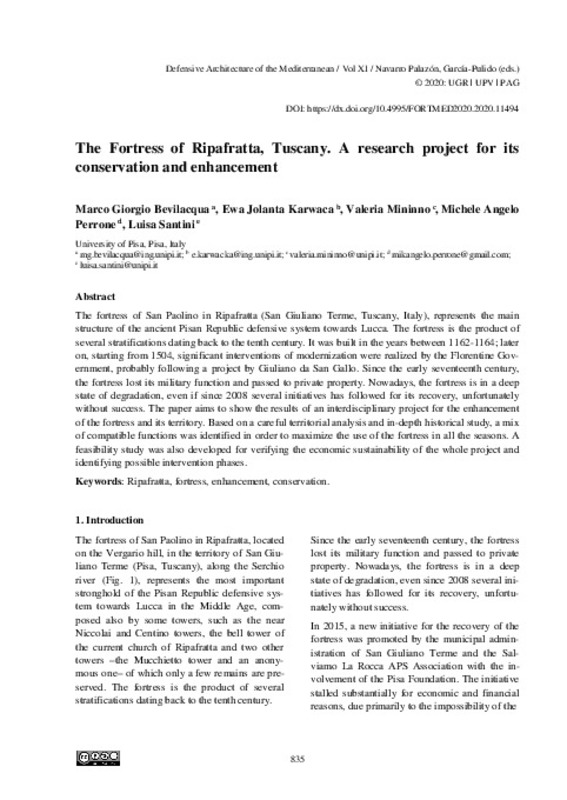JavaScript is disabled for your browser. Some features of this site may not work without it.
Buscar en RiuNet
Listar
Mi cuenta
Estadísticas
Ayuda RiuNet
Admin. UPV
The Fortress of Ripafratta, Tuscany. A research project for its conservation and enhancement
Mostrar el registro sencillo del ítem
Ficheros en el ítem
| dc.contributor.author | Bevilacqua, Marco
|
es_ES |
| dc.contributor.author | Karwaca, Ewa
|
es_ES |
| dc.contributor.author | Mininno, Valeria
|
es_ES |
| dc.contributor.author | Perrone, Michele
|
es_ES |
| dc.contributor.author | Santini, Luisa
|
es_ES |
| dc.coverage.spatial | east=10.4168299; north=43.820315; name=da Ripafratta Pisa a al ponte della Vittoria a Pisa, 56017 San Giuliano Terme PI, Itàlia | es_ES |
| dc.date.accessioned | 2020-07-06T11:56:23Z | |
| dc.date.available | 2020-07-06T11:56:23Z | |
| dc.date.issued | 2020-05-15 | |
| dc.identifier.isbn | 9788490488560 | |
| dc.identifier.uri | http://hdl.handle.net/10251/147494 | |
| dc.description.abstract | [EN] The fortress of San Paolino in Ripafratta (San Giuliano Terme, Tuscany, Italy), represents the main structure of the ancient Pisan Republic defensive system towards Lucca. The fortress is the product of several stratifications dating back to the tenth century. It was built in the years between 1162-1164; later on, starting from 1504, significant interventions of modernization were realized by the Florentine Government, probably following a project by Giuliano da San Gallo. Since the early seventeenth century, the fortress lost its military function and passed to private property. Nowadays, the fortress is in a deep state of degradation, even if since 2008 several initiatives has followed for its recovery, unfortunately without success. The paper aims to show the results of an interdisciplinary project for the enhancement of the fortress and its territory. Based on a careful territorial analysis and in-depth historical study, a mix of compatible functions was identified in order to maximize the use of the fortress in all the seasons. A feasibility study was also developed for verifying the economic sustainability of the whole project and identifying possible intervention phases. | es_ES |
| dc.language | Inglés | es_ES |
| dc.publisher | Editorial Universitat Politècnica de València | es_ES |
| dc.rights | Reconocimiento - No comercial - Sin obra derivada (by-nc-nd) | es_ES |
| dc.subject | Fortifications | es_ES |
| dc.subject | Mediterranean | es_ES |
| dc.subject | Modern age | es_ES |
| dc.subject | Built Heritage | es_ES |
| dc.subject | Ripafratta | es_ES |
| dc.subject | Fortress | es_ES |
| dc.subject | Enhancement | es_ES |
| dc.subject | Conservation | es_ES |
| dc.title | The Fortress of Ripafratta, Tuscany. A research project for its conservation and enhancement | es_ES |
| dc.type | Capítulo de libro | es_ES |
| dc.type | Comunicación en congreso | es_ES |
| dc.identifier.doi | 10.4995/FORTMED2020.2020.11494 | |
| dc.rights.accessRights | Abierto | es_ES |
| dc.description.bibliographicCitation | Bevilacqua, M.; Karwaca, E.; Mininno, V.; Perrone, M.; Santini, L. (2020). The Fortress of Ripafratta, Tuscany. A research project for its conservation and enhancement. Editorial Universitat Politècnica de València. 835-842. https://doi.org/10.4995/FORTMED2020.2020.11494 | es_ES |
| dc.description.accrualMethod | OCS | es_ES |
| dc.relation.conferencename | FORTMED2020 - Defensive Architecture of the Mediterranean | es_ES |
| dc.relation.conferencedate | Octubre 01-03,2020 | es_ES |
| dc.relation.conferenceplace | Granada, Spain | es_ES |
| dc.relation.publisherversion | http://ocs.editorial.upv.es/index.php/FORTMED/FORTMED2020/paper/view/11494 | es_ES |
| dc.description.upvformatpinicio | 835 | es_ES |
| dc.description.upvformatpfin | 842 | es_ES |
| dc.type.version | info:eu-repo/semantics/publishedVersion | es_ES |
| dc.relation.pasarela | OCS\11494 | es_ES |








